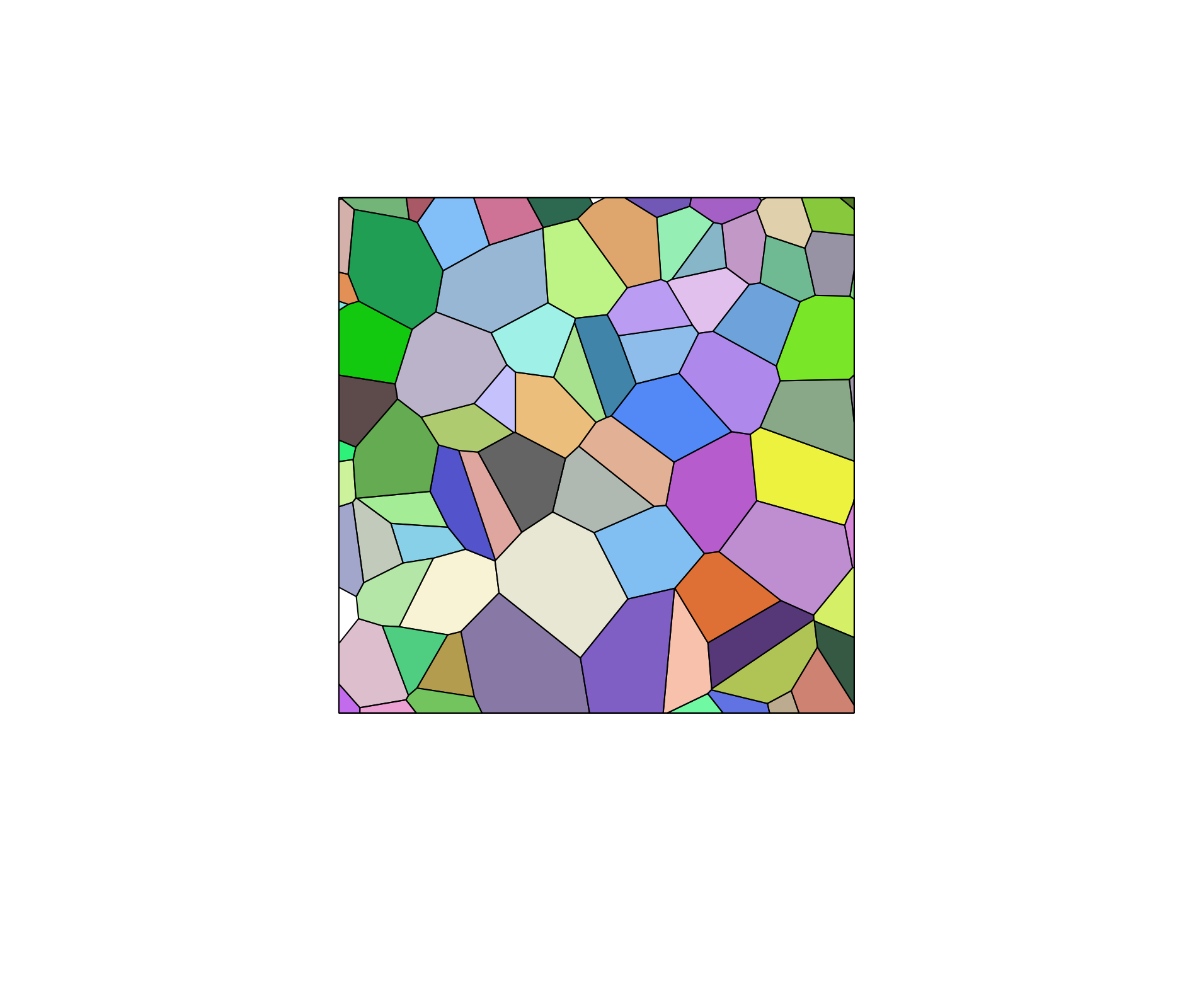CGAL, Обрезанная вороноая диаграмма, заключенная в прямоугольник
Я использую CGAL с Qt, чтобы нарисовать диаграмму Вороного. я использовал CGAL::Voronoi_diagram_2<DT,AT,AP>так как мне нужны лица. Это пример кода:
for(Face_iterator f = VD.faces_begin(); f != VD.faces_end(); f++)
{
Ccb_halfedge_circulator ec_start = (f)->ccb();
Ccb_halfedge_circulator ec = ec_start;
do {
if (!ec->has_source())
{
}
else
QpolyF << QPointF(((Halfedge_handle)ec)->source()->point().x(), ((Halfedge_handle)ec)->source()->point().y());
} while ( ++ec != ec_start );
VectPolygon.push_back(QpolyF);
QpolyF.clear();}
Мне нужно обрезать лучи, которые имеют источник или цель в бесконечности. Если я использую Cropped_voronoi_from_delaunay для генерации вороной, он дает только сегменты, а не грани. это typedefs:
typedef K::Line_2 Line_2;
typedef CGAL::Delaunay_triangulation_2<K> Delaunay_triangulation_2;
typedef Delaunay_triangulation_2::Face_iterator dt_Face_iterator;
typedef Delaunay_triangulation_2::Edge_circulator dt_Edge_circulator;
// typedefs for defining the adaptor
typedef CGAL::Exact_predicates_inexact_constructions_kernel K;
typedef CGAL::Delaunay_triangulation_2<K> DT;
typedef CGAL::Delaunay_triangulation_adaptation_traits_2<DT> AT;
typedef CGAL::Delaunay_triangulation_caching_degeneracy_removal_policy_2<DT> AP;
typedef CGAL::Voronoi_diagram_2<DT,AT,AP> VD;// typedef for the result type of the point location
typedef AT::Site_2 Site_2;
typedef AT::Point_2 Point_2;
typedef VD::Locate_result Locate_result;
typedef VD::Vertex_handle Vertex_handle;
typedef VD::Face_handle Face_handle;
typedef VD::Face_iterator Face_iterator;
typedef VD::Halfedge_handle Halfedge_handle;
typedef VD::Ccb_halfedge_circulator Ccb_halfedge_circulator;
Решение
Здесь есть некоторый экспериментальный код: http://code.google.com/p/cgal-voronoi-cropping которые обрезают диаграмму Вороного до прямоугольника, в результате получается HDS. Смотрите main.cpp в тестовом каталоге
Другие решения
Я знаю, что это можно сделать с помощью CGAL, но я нашел обходной путь. в Qt класс QPolygon имеет функцию поиска пересекающихся многоугольников. Qpolygon::intersected(yourPolygon),
это результаты:
Далее будет сгенерировано случайное облако точек, найдена его диаграмма Вороного, обрезана эта диаграмма до ограничивающей рамки облака и сгенерированы хорошо известные текстовые полигоны.
Я не уверен, как интегрировать это с Qt, но, предположительно, когда у вас есть полигоны, эта часть будет легкой (иш).
//Finds the cropped Voronoi diagram of a set of points and saves it as WKT
//Compile with: g++ main.cpp -Wall -lCGAL -lgmp
//Author: Richard Barnes (rbarnes.org)
#include <CGAL/Exact_predicates_exact_constructions_kernel.h>
#include <CGAL/Regular_triangulation_filtered_traits_2.h>
#include <CGAL/Regular_triangulation_adaptation_traits_2.h>
#include <CGAL/Regular_triangulation_adaptation_policies_2.h>
#include <CGAL/Regular_triangulation_2.h>
#include <CGAL/Voronoi_diagram_2.h>
#include <CGAL/Boolean_set_operations_2.h>
#include <CGAL/bounding_box.h>
#include <CGAL/Polygon_2.h>
#include <iostream>
#include <cstdint>
//Used to convert otherwise infinite rays into looooong line segments
const int RAY_LENGTH = 1000;
typedef CGAL::Exact_predicates_exact_constructions_kernel K;
typedef CGAL::Regular_triangulation_filtered_traits_2<K> Traits;
typedef CGAL::Regular_triangulation_2<Traits> RT2;
typedef CGAL::Regular_triangulation_adaptation_traits_2<RT2> AT;
typedef CGAL::Regular_triangulation_degeneracy_removal_policy_2<RT2> DRP;
typedef CGAL::Voronoi_diagram_2<RT2, AT, DRP> VD;
int main(int argc, char **argv){
std::vector<RT2::Weighted_point> wpoints;
std::cout.precision(4);
std::cout.setf(std::ios::fixed);
//Generated random points
for(int i=0;i<100;i++)
//Weight of 0 gives a Voronoi diagram. Non-zero weight gives a power diagram
wpoints.push_back(RT2::Weighted_point(K::Point_2(rand()%100,rand()%100), 0));
//Find the bounding box of the points. This will be used to crop the Voronoi
//diagram later.
const K::Iso_rectangle_2 bbox = CGAL::bounding_box(wpoints.begin(), wpoints.end());
//Create a Regular Triangulation from the points
RT2 rt(wpoints.begin(), wpoints.end());
rt.is_valid();
//Wrap the triangulation with a Voronoi diagram adaptor. This is necessary to
//get the Voronoi faces.
VD vd(rt);
//CGAL often returns objects that are either segments or rays. This converts
//these objects into segments. If the object would have resolved into a ray,
//that ray is intersected with the bounding box defined above and returned as
//a segment.
const auto ConvertToSeg = [&](const CGAL::Object seg_obj, bool outgoing) -> K::Segment_2 {
//One of these will succeed and one will have a NULL pointer
const K::Segment_2 *dseg = CGAL::object_cast<K::Segment_2>(&seg_obj);
const K::Ray_2 *dray = CGAL::object_cast<K::Ray_2>(&seg_obj);
if (dseg) { //Okay, we have a segment
return *dseg;
} else { //Must be a ray
const auto &source = dray->source();
const auto dsx = source.x();
const auto dsy = source.y();
const auto &dir = dray->direction();
const auto tpoint = K::Point_2(dsx+RAY_LENGTH*dir.dx(),dsy+RAY_LENGTH*dir.dy());
if(outgoing)
return K::Segment_2(
dray->source(),
tpoint
);
else
return K::Segment_2(
tpoint,
dray->source()
);
}
};
//First line of WKT CSV output
std::cout<<"\"id\",\"geom\"\n";
int fnum = 0;
//Loop over the faces of the Voronoi diagram in some arbitrary order
for(VD::Face_iterator fit = vd.faces_begin(); fit!=vd.faces_end();++fit,fnum++){
CGAL::Polygon_2<K> pgon;
//Edge circulators traverse endlessly around a face. Make a note of the
//starting point so we know when to quit.
VD::Face::Ccb_halfedge_circulator ec_start = fit->ccb();
//Find a bounded edge to start on
for(;ec_start->is_unbounded();ec_start++){}
//Current location of the edge circulator
VD::Face::Ccb_halfedge_circulator ec = ec_start;
do {
//A half edge circulator representing a ray doesn't carry direction
//information. To get it, we take the dual of the dual of the half-edge.
//The dual of a half-edge circulator is the edge of a Delaunay triangle.
//The dual of the edge of Delaunay triangle is either a segment or a ray.
// const CGAL::Object seg_dual = rt.dual(ec->dual());
const CGAL::Object seg_dual = vd.dual().dual(ec->dual());
//Convert the segment/ray into a segment
const auto this_seg = ConvertToSeg(seg_dual, ec->has_target());
pgon.push_back(this_seg.source());
//If the segment has no target, it's a ray. This means that the next
//segment will also be a ray. We need to connect those two rays with a
//segment. The following accomplishes this.
if(!ec->has_target()){
const CGAL::Object nseg_dual = vd.dual().dual(ec->next()->dual());
const auto next_seg = ConvertToSeg(nseg_dual, ec->next()->has_target());
pgon.push_back(next_seg.target());
}
} while ( ++ec != ec_start ); //Loop until we get back to the beginning
//In order to crop the Voronoi diagram, we need to convert the bounding box
//into a polygon. You'd think there'd be an easy way to do this. But there
//isn't (or I haven't found it).
CGAL::Polygon_2<K> bpoly;
bpoly.push_back(K::Point_2(bbox.xmin(),bbox.ymin()));
bpoly.push_back(K::Point_2(bbox.xmax(),bbox.ymin()));
bpoly.push_back(K::Point_2(bbox.xmax(),bbox.ymax()));
bpoly.push_back(K::Point_2(bbox.xmin(),bbox.ymax()));
//Perform the intersection. Since CGAL is very general, it believes the
//result might be multiple polygons with holes.
std::list<CGAL::Polygon_with_holes_2<K>> isect;
CGAL::intersection(pgon, bpoly, std::back_inserter(isect));
//But we know better. The intersection of a convex polygon and a box is
//always a single polygon without holes. Let's assert this.
assert(isect.size()==1);
//And recover the polygon of interest
auto &poly_w_holes = isect.front();
auto &poly_outer = poly_w_holes.outer_boundary();
//Print the polygon as a WKT polygon
std::cout<<fnum<<", ""\"POLYGON ((";
for(auto v=poly_outer.vertices_begin();v!=poly_outer.vertices_end();v++)
std::cout<<v->x()<<" "<<v->y()<<", ";
std::cout<<poly_outer.vertices_begin()->x()<<" "<<poly_outer.vertices_begin()->y()<<"))\"\n";
}
return 0;
}

